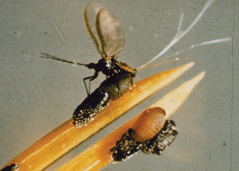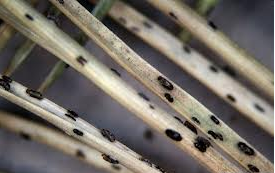 Pinyon pine is a beautiful tree, offering incredible structure to a desert. One of the slowest growing trees among the conifers, the Pinyon pine can take up to a hundred years to produce a single cone. The trees yield edible pinyon nuts, which are widely eaten by the Native Americans. Annual harvest of wild pinyon nuts exceeds a million pounds! The wood, especially when burned, has a distinctive fragrance, making it a common wood to burn in chimineas. The pinyon pine trees are also known to influence the soil in which they grow. Sadly, these amazing trees are under attack by small, black, bean shaped invasive insects known as the Pinyon needle scales. These insects can cause the leaves of Pinyon pine trees to fall off and could also kill the tree!
Pinyon pine is a beautiful tree, offering incredible structure to a desert. One of the slowest growing trees among the conifers, the Pinyon pine can take up to a hundred years to produce a single cone. The trees yield edible pinyon nuts, which are widely eaten by the Native Americans. Annual harvest of wild pinyon nuts exceeds a million pounds! The wood, especially when burned, has a distinctive fragrance, making it a common wood to burn in chimineas. The pinyon pine trees are also known to influence the soil in which they grow. Sadly, these amazing trees are under attack by small, black, bean shaped invasive insects known as the Pinyon needle scales. These insects can cause the leaves of Pinyon pine trees to fall off and could also kill the tree!
These tiny, sap-sucking insects kill the needles and severely weaken Pinyon pines in forests. Reduced new growth and stunted needles are common on trees suffering repeated attacks. The needle length is reduced and needles drop prematurely. Heavy infestations frequently kill small trees and predispose weakened larger trees to attack by other insects. Feeding by adult females and nymphs causes the needles to turn yellow and prematurely fall. Most defoliation occurs on older needles, producing a tufted appearance with younger needles primarily persisting on infested trees. Small trees with scales can die in a few years when untreated. However, larger trees suffer more slowly, losing one or a couple branches at a time until they die.
 This insect is most common and damaging in the United States, particularly in southern Colorado. Historic outbreaks were noted in 1957-1963 in southeast Nevada and southwest Utah, affecting several hundred thousand acres. In 2009, approximately 7% of Nevada’s pinyon forest mapped was affected by this insect. In 2010, nearly 1,161,000 acres of the approximately 9,950,000 acres of pinyon in Nevada were mapped as scale-defoliated.This represents 11.6% of Nevada’s pinyon forest!
This insect is most common and damaging in the United States, particularly in southern Colorado. Historic outbreaks were noted in 1957-1963 in southeast Nevada and southwest Utah, affecting several hundred thousand acres. In 2009, approximately 7% of Nevada’s pinyon forest mapped was affected by this insect. In 2010, nearly 1,161,000 acres of the approximately 9,950,000 acres of pinyon in Nevada were mapped as scale-defoliated.This represents 11.6% of Nevada’s pinyon forest!
The graveness of the issue can be better understood from the following article,
Pinyon needle scale eggs killing trees in some AZ cities
Allison Miller
Apr 11, 2011
PRESCOTT, AZ – Spring is providing us with warmer temperatures and beautiful spring blooms.
However, these warmer temperatures have already caused native insects, called pinyon needle scales to emerge.
These insects can cause leaves of Pinyon pine trees to fall off and could also kill the tree.
Because of the warm temperatures, the female scales have already laid their eggs on the trees and will hatch in May.
They can be found over thousands of acres including the Prescott area up the northwest to the Williamson Valley and are also spreading across the Payson area.
They look like noticable clusters of yellow eggs held together in loose, white, cottony webbing found in branch crotches, along the underside of branches, on the trunk, and at the base of the tree.
Bob Celaya, Forest Health Specialist says the eggs need to be spotted and treated as quickly as possible since they can kill small trees within a few years and large trees may take several years to die.
Evidently, unless proper measures are taken, the Pinyon pines may soon become extinct due to the Pinyon needle scale. Infested pine trees can be treated with chemicals and insecticides or by washing off the eggs from the surface of the trees before they get a chance to hatch. However, the efforts and costs associated with these methods, as well as the environmental safety concerns about applying toxic insecticides, make these techniques less feasible on a broad scale in natural areas.
C Tech Corporation can offer a solution to overcome this problem. Our product Combirepel™ is an extremely low toxicity and extremely low hazard and eco-friendly rodent aversive. Combirepel™ is available in the form of solid masterbatches, liquid concentrate and in lacquer form. The product is compliant with RoHS, RoHS2, and REACH and is FIFRA exempted. This product acts through a series of highly developed intricate mechanism ensuring that rodents are kept away from the target application.
The fencing and tree guards can be coated withCombirepel™ to protect the trees, shrubs etc. from the damage caused by the grey squirrels. The product can also be incorporated into agricultural films, greenhouse films, plastic mulches used on a large scale in the agriculture as well as horticulture sector in order to avoid damages caused by these squirrels to fruits and vegetables. Also, the products can be directly incorporated in the polymer matrix during processing of pipes and tubing. Combirepel™ does not leach out, thus there is no soil pollution. Groundwater reserves are also not polluted. Also the non-target beneficial species like earthworms, bees etc are not affected.
The product is compliant with ROHS, ROHS2, ISO, REACH, APVMA, NEA, EU-BPR, and FIFRA exempted.
Contact us at technical.marketing@ctechcorporation.com if you’re facing problems with rodents and get best remedies to combat the pest menace.
Also, visit our websites:
http://www.ctechcorporation.com/
http://www.rodrepel.com/
http://www.termirepel.com/
http://www.combirepel.com/
Follow our Facebook pages at:
1] https://www.facebook.com/Combirepel-411710912249274/
2] https://www.facebook.com/Termirepel-104225413091251/
3] https://www.facebook.com/Rodrepel-120734974768048/
Follow us on our Twitter pages at:
1] https://twitter.com/rodrepel
2] https://twitter.com/termirepel
3] https://twitter.com/combirepel

